Falls are preventable. Falls generally are accidental + unplanned but the risk of falling can be reduced.
Slips, trips and falls are the second highest single cause of workplace injuries + are more likely to lead to significant time off work than other accidents. They represent nearly 50% of all claims made against retailers.
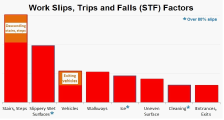
Slips account for 80% of all slips, trips and falls where floors are wet, slippery or during cleaning.
Factors to watch for include:
- Stairs and steps - esp descending
- Slippery wet surfaces.
- Gender - many victims are female.
- Cleaning - wet floors, trailing cables, obstructed walkways etc
- Over-use of signs. Signs did not prevent many cleaning slips.
- Footwear
- Vehicles, especially exiting vehicles.
- Ice (and snow).
- Entrances + exits - Mats and floor surfaces.
Key areas to consider when assessing the risk for slips, trips and falls include
- spills,
- high risk areas,
- over-used warning signs,
- environmental cleanliness and
- Shoes Top
Spills
Spills can occur in every workplace. To reduce the associated risk;
- Deal with spills straight away
- Routine monitoring of risk areas
- Have absorbent material close by.
- Avoid using wet cleaning.
- Consider using spill kits
- Slip resistant footwear
- Identifying areas where spills may occur,
- sources of liquid.
- self-service drinks areas.
- Walk-in chiller and freezer
- fruit/vegetable on a floor

A Fall
is a sudden uncontrolled movement causing the body to move downwards to make contact with a lower level or the ground, typically rapidly and without control.
A slip
is to lose one's footing (base of support) which causes an unintentionally slide for a short distance. This may result in a fall if the centre of gravity comes outside of the base of support.
A trip
is to catch one's foot unexpectedly on something while moving causing one to stumble or fall.
The Health T+ Safety Authority HSA Definitions

High Risk Areas
High risk areas need to be identified.
The floor in a workplace must be suitable for its use. Where a floor isn’t dry, people shouldn’t be afraid of slipping on it.
High risk areas include where pedestrians move between floors with different grip. It is important that:
- Excess moisture is removed from footwear
- Mats provided are properly designed/+ fitted
- Mats provided are placed where people walk
- Slopes, ramps, steps/stairs, bumps, drainage channels etc should have correct controls:
- Slip resistant surfaces
- Proper lighting
- Level changes highlighted
- Proper drain covers
- Stairs are kept clean & tidy
- Avoid carrying items on stairs
Damaged flooring is high risk so have it repaired.
Trailing cables and hoses are a trip hazard. Control measures include:
- Reroute them if possible
- Position electrical outlets to avoid trailing cables
- Place equipment close to electrical outlets
- Avoid the use of extension cables
- Use retractable reels
- Where a trailing cable is temporarily, fix it down
Slippery surfaces are also high risk areas.
- Consider changing or treating floor surfaces
- Consider effect of severe weather - Grit or salt
- Ensure slip resistant footwear is provided Top
Over Used Warning Signs
Warning signs do not physically keep people away from wet floors.
During cleaning keep pedestrians away from wet floors by using physical barriers.
Remove when cleaning is finished
Environmental Cleanliness
Good housekeeping is for everyone and may include:
- Ensure the walkways are kept clear
- Tidy as you go
- Keep access routes clear
- Keep pedestrians away from messy operations
- Dispose of packing and wrappings carefully.
- For routine cleaning:
- Ensure cleaning staff are trained
- Provide staff with slip resistant footwear
- Assess if cleaning is actually required
- Use dry cleaning methods if practical
- Clean floors at times when minimum traffic
- Cordon off the floor area being cleaned
- Organise for a safe pathway
- Where wet cleaning, use with the minimum detergent possible.
- Remove excess water to assist drying
Shoes (Safety Footwear)
Employers should provide footwear if needed at no cost to the employee. Consider the following;
- Good tread pattern - the more edges = firmer grip
- They be comfortable + fit well
- Trial use of the footwear for suitability
- Ensure works in dry + wet conditions.
- Tread may clog with debris.
- Use clogs with an ankle strap
- Overshoes have slip resistance
- Level of slip resistance.
- Ease of cleaning and maintenance
- Avoid open shoes, sandals, flip-flops
Employer’s Responsibility
Employers have a responsibility to control risks from slips, trips and falls. This includes:
1. Conducting slips, trips and falls risk assessment(s)
2. Conducting audits ensure responsibilities are met
3. Providing slip-resistant footwear if required
4. Ensuring employees receive appropriate training
Employee’s Responsibility
Employees have a responsibilities too, including:
1. Reporting anything dangerous, e.g. spills
2. Taking proper care
3. Using equipment provided correctly - footwear. Back to Top
Falls and Frailty in Older People
Many falls do not result in injury but do impact on confidence and increase fear. Many falls are preventable.
Falls represent over half of all hospital admissions for accidental injury amongst older people
Who is most at risk?
- Frail older people
- Those with long term physical or sensory impairments conditions that adversely affect the ability to stop a fall - stroke, Parkinson’s, arthritis, visual impairment
- Those with mental health / learning disabilities - unaware of the risks of falling
How much risk?
Any YES answer = increased risk. If there are 3+ YES answers there is a high risk of falling.
- Have you had a history of falling in the past year?
- Are you on four or more prescribed medications?
- Do you have a history of stroke or Parkinson’s?
- Have you experienced any problems with balance?
- Are you unable to rise from a chair without using your arms + hands?
Risk factors that are not not modifiable with exercise include age, gender, chronic medical conditions, + non-correctable vision.
Risk factors that are modifiable include poor balance, fear of falling, low strength and power, poor gait and functional ability, depression and arthritic pain, which may all be helped by exercise.
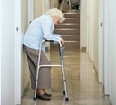

How to Stay Safe + Avoiding Falling
Older people should generally ‘not slow down + take it easy’. If older people stay active they will maintain their joints, muscles and nerves, which enables normal movement to continue.
Exercise will help maintain / improve balance and reduces the risk of falls. Therefore:
- Keep fit! Take up an enjoyable physical activity.
- Speak to a chartered physiotherapist for advice on exercise to improve your strength and balance
- Eat a balanced diet and keep the body hydrated
- Check for slipping / tripping hazards – rugs, mats, obstacles around the house
Dealing with Falls
If you or a relative has suffered from repeated falls, speak to a physiotherapist, occupational therapist or GP to discuss having a Falls Assessment. You can also:
- Get a pendant alarm
- Learn how to get off the floor
- Position cushions + blankets within reach if needed if stuck on the floor
- Carry a phone around to summon help.
Role of A Chartered Physiotherapist
If you are worried about falls you should seek advice from a chartered physiotherapist. They can advise on keeping mobile, flexible and preventing a fall.
Physiotherapists can help with advice on:
- Strength
- Co-ordination
- Balance
- Flexibility
- Endurance for physical enhancement
- Confidence
Physiotherapists may also assess a home for slipping + tripping hazards and then;-
- Refer to other professionals as appropriate - OT.
- Developing an individualised plan of action
- Minimise the risk of a ‘long lie’ on the floor by teaching people how to get up from the floor
- They can prescribe suitable exercise options in the home or in the community.
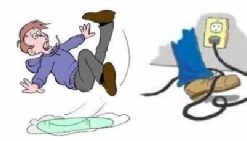
Many older people do not injure themselves in a fall, but have great difficulty getting up again after the fall, If they remain on the floor for some time - ‘a long lie’ - this can lead to shock, hypothermia, fear of further injury etc. Alack of physical fitness or knowledge how to get back up may keep a person on the floor. Training on how to get up may be useful for those who are at risk of falling.
For those who have not yet fallen, there are many types of exercise that can help – like Tai Chi, dancing and bowls.
A Falls Exercise Programme should (re)train the ability to get up from the floor. It should also practice other skills such as crawling + rolling, summoning help and keeping warm while on the floor.
Key Messages for Fallers
- Exercise to prevent falls should be individualised
- Not all types of exercise prevent falls
- Exercise prescription will differ depending on the individuals fitness needs and medical history.
- Exercise to prevent first falls should include balance and strength training activities, dynamic balance, functional floor activities, posture + gait training.
- Falls Exercise can be home or group based
- Exercise should include getting up from the floor after having fallen.
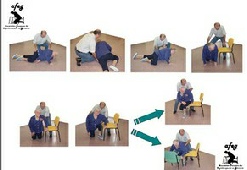
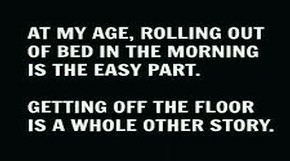
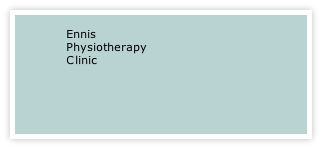




Mon - Fri 9.30am - 8.30pm


3A Barrack Close, Barrack St., Ennis, Co. Clare V95 X437

065 6840757
| Health+Safety Services |
| Sports Clubs+Teams Services |
| Standing Posture |
| Sitting Posture |
| Childhood Posture |
| Using Portable Devices |
| Normal Walking |
| Running |
| Running Drills Videos |
| Muscle Energetics |
| General Fitness |
| Losing Body Weight |
| Gaining Body Weight |
| Weight Loss Programmes |
| Start to Run |
| Start to Swim |
| Start Cycling |
| Start Nordic Waliking |
| Rehab of Tensdons |
| Loading of Tendons |
| Non Specific LBP |
| Posture |
| Intervertebral Disc |
| LBP Treatment |
| Non Specific Neck Pain |
| Neck Care Advice |
| Hamstring Strain |
| Ankle Sprain |
| ACL Injury |
| Joint Replacement |
| Shoulder Dislocation |
| Tennis Elbow |
| Wrist fracture |
| Fractured Knuckle |
| Selecting a Racquet |
| Racquet Grip Size |
| Racuet Sport Injuries |
| Training for Racquet Sports |
| Ski + Board Injuries |
| Injury Videos |
| Injury Prevention |
| Preventing Injury in Musicians |
| Irish Dancing |
| Preventing Dance Injury |